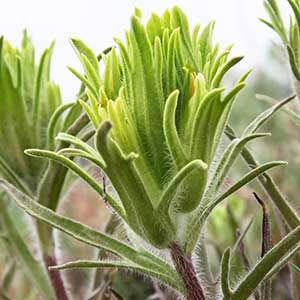Castilleja rubida
Castilleja oresbia
little reddish Indian paintbrush, purple alpine paintbrush, purple paintbrush, Wallowa alpine paintbrush
pale paintbrush, pale Wallowa Indian paintbrush, pale Wallowa paintbrush
several, decumbent, or ascending, unbranched, hairs moderately dense, spreading, short and long, soft, eglandular and glandular.
few to several, erect or ascending, sometimes decumbent at base, unbranched or branched, hairs usually retrorse, medium length, ± soft, eglandular, mixed with very short-glandular ones, sometimes with spreading, long, soft ones.
green to purple, linear to narrowly lanceolate, 0.7–3.2 cm, not fleshy, margins plane, slightly involute, 3–5-lobed, apex narrowly acute to acuminate;
lobes ascending-spreading, narrowly linear to filiform, often curling, often short, apex acute or obtuse.
green to purple, linear to lanceolate, 2–7 cm, not fleshy, margins plane, involute, 3–5(–7)-lobed, apex acuminate to acute;
lobes spreading, linear to sometimes narrowly lanceolate, apex acute.
2.5–6 × 1–2 cm;
bracts purple, deep burgundy, or lavender throughout, rarely pink or yellowish white throughout, sometimes pink or dull whitish on distal margins and apices, oblong, 3–5(–7)-lobed;
lobes spreading, linear, medium length, proximal lobes arising below mid length, center lobe apex rounded to obtuse, lateral ones acute to obtuse.
2.5–18 × 1–3.5 cm;
bracts pale green to yellow-green or pale, dull reddish brown throughout, or proximally so colored but changing gradually to cream or yellowish on distal margins, narrowly to broadly lanceolate, (3–)5–7(–9)-lobed;
lobes ascending, linear, long, proximal lobes arising below mid length, central lobe apex obtuse, others acute.
straight, 12–15 mm;
tube 14–16 mm;
abaxial lip and beak exserted;
beak adaxially green, 5–6 mm;
abaxial lip colored as distal portion of bracts, prominent, pouches 3, central one grooved, pouches not strongly inflated, 4–5 mm, 80–100% as long as beak;
teeth erect, appressed to beak, colored as distal portions of bracts, 1.5–2.5 mm.
straight, 21–36 mm;
tube 16–20 mm;
teeth of abaxial lip often exserted, beak exserted;
beak adaxially green, 4.2–5.5 mm;
abaxial lip green to purple, distally white, conspicuous, slightly but noticeably pouched, often visible through front cleft, 3–5 mm, 67–100% as long as beak, puberulent;
teeth erect, white, 1.8–2.1 mm.
colored as bracts, 10–12 mm; all 4 clefts subequal, 3.5–6.5 mm, 35–55% of calyx length;
lobes broadly linear or linear-triangular, apex obtuse to acute.
colored as bracts, 10–25 mm;
abaxial and adaxial clefts 6–7 mm, 30–60% of calyx length, deeper than laterals, lateral 5–10 mm, 40–50% of calyx length;
lobes linear, apex acute.
green.
Castilleja rubida
Castilleja oresbia
Castilleja rubida is a rare alpine species endemic to a few limestone peaks in the Wallowa Mountains of northeastern Oregon, entirely within the Eagle Cap Wilderness Area. It is likely derived from the C. nana complex, found in the mountains of eastern California and Nevada, but it is amply distinct. Due to its very limited range and small population numbers, C. rubida is a species of conservation concern.
(Discussion copyrighted by Flora of North America; reprinted with permission.)
Castilleja oresbia is endemic to eastern Oregon and adjacent Idaho. It is easily confused with both varieties of C. pallescens, which also occur in sagebrush habitats. Castilleja oresbia has longer calyx lobes and softer pubescence than C. pallescens var. pallescens, although some transitional specimens are found. Castilleja oresbia has a combination of longer calyx lobes, longer pubescence, and obscurely nerved bracts, which usually serve to separate it from C. pallescens var. inverta. All three have different, though somewhat overlapping, ranges. Castilleja oresbia occasionally hybridizes with C. peckiana in Grant County, Oregon.
(Discussion copyrighted by Flora of North America; reprinted with permission.)


